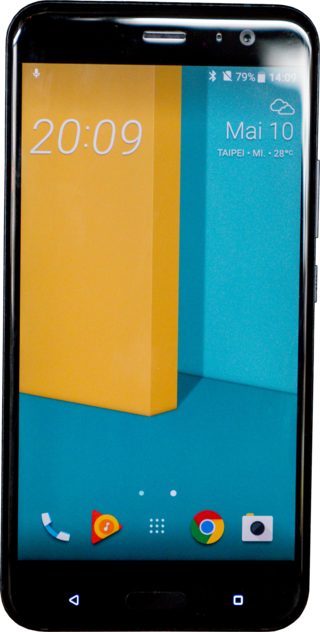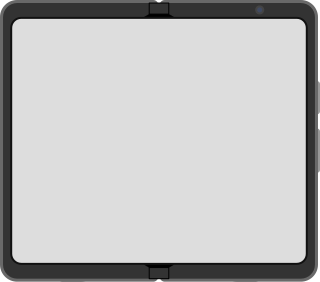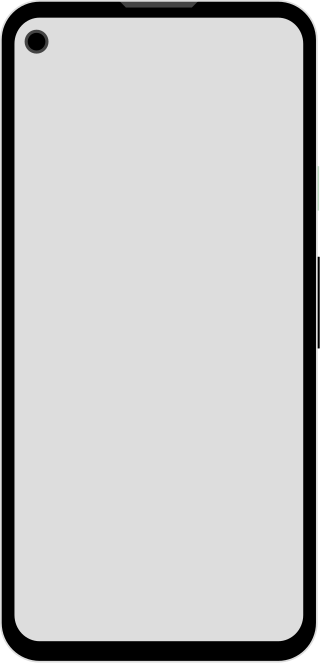Dragontrail is an alkali-aluminosilicate sheet glass manufactured by AGC Inc. It is engineered for a combination of thinness, lightness and damage-resistance, similarly to Corning's proprietary Gorilla Glass. The material's primary properties are its strength, allowing thin glass without fragility; its high scratch resistance; and its hardness – with a Vickers hardness test rating of 595 to 673.
Google Pixel is a brand of portable consumer electronic devices developed by Google that run either ChromeOS or the Android operating system. The main line of Pixel products consist of Android-powered smartphones, which have been produced since October 2016 as the replacement of the older Nexus, and of which the Pixel 8 and 8 Pro are the current models. The Pixel brand also includes laptop and tablet computers, as well as several accessories, and was originally introduced in February 2013 with the Chromebook Pixel.

Pixel Camera, formerly Google Camera, is a camera phone application developed by Google for the Android operating system. Development for the application began in 2011 at the Google X research incubator led by Marc Levoy, which was developing image fusion technology for Google Glass. It was publicly released for Android 4.4+ on the Google Play on April 16, 2014. It was initially supported on all devices running Android 4.4 KitKat and higher, but became only officially supported on Google Pixel devices in the following years. The app was renamed Pixel Camera in October 2023, with the launch of the Pixel 8 and Pixel 8 Pro.

The Nexus 5X is an Android smartphone manufactured by LG Electronics, co-developed with and marketed by Google as part of its Nexus line of flagship devices. Unveiled on September 29, 2015, it was a successor to the Nexus 5. The phone, along with the Nexus 6P, served as launch devices for Android 6.0 Marshmallow, which introduced a refreshed interface, performance improvements, increased Google Now integration, and other new features.

Nexus 6P is an Android smartphone developed and marketed by Google and manufactured by Huawei. It succeeded the Nexus 6 as the flagship device of the Nexus line of Android devices by Google. Officially unveiled on 29 September 2015 along with the Nexus 5X at the Google Nexus 2015 press event held in San Francisco, it was made available for pre-order on the same day in United States, United Kingdom, Ireland, and Japan.

The HTC One A9 is an Android smartphone manufactured and marketed by HTC. It was officially announced on October 20, 2015. It is the successor to the HTC One Mini 2 worldwide; but in global markets, it was sold alongside the One M9 as a mid-range offering. It was launched as an effort to improve the revenue of HTC's smartphone business after the failure of the One M9.

Daydream is a discontinued virtual reality (VR) platform which was developed by Google, primarily for use with a headset into which a smartphone is inserted. It is available for select phones running the Android mobile operating system that meet the platform's software and hardware requirements. Daydream was announced at the Google I/O developer conference in May 2016, and the first headset, the Daydream View, was released on November 10, 2016. To use the platform, users place their phone into the back of a headset, run Daydream-compatible mobile apps, and view content through the viewer's lenses.
DXOMARK is a commercial website described as "an independent benchmark that scientifically assesses smartphones, lenses and cameras". Founded in 2008, DxOMark was originally owned by DxO Labs, a French engineering and consulting company, which is headquartered in Boulogne-Billancourt, Paris, France. DXOMARK Image Labs was separated from DxO Labs in September 2017, and was later re-branded to DXOMARK in 2019. DXOMARK is now a wholly independent privately-owned company.
The Pixel and Pixel XL are a pair of Android smartphones designed, developed, and marketed by Google as part of the Google Pixel product line, succeeding the Nexus line of smartphones. They were officially announced on October 4, 2016 at the Made by Google event and released in the United States on October 20. On October 4, 2017, they were succeeded by the Pixel 2 and Pixel 2 XL.

The HTC U11 is an Android smartphone manufactured and sold by HTC as part of the HTC U series. It was announced on 16 May 2017 and succeeds the HTC 10 smartphone. In the United States, the HTC U11's major carrier is Sprint; however, it is also compatible with unlocked carriers, such as AT&T, T-Mobile, and Verizon.

The Phab 2 Pro is an Android smartphone in a phablet form factor, developed and produced by Lenovo and first released in November 2016 at an MSRP of US$499. The device is notable for being the first consumer smartphone to support Google Tango augmented reality (AR) technology.
The Pixel 2 and Pixel 2 XL are a pair of Android smartphones designed, developed, and marketed by Google as part of the Google Pixel product line. They collectively serve as the successors to the Pixel and Pixel XL. They were officially announced on October 4, 2017 at the Made by Google event and released in the United States on October 19. On October 9, 2018, they were succeeded by the Pixel 3 and Pixel 3 XL.

The following is a comparative list of smartphones belonging to the Google Pixel line of devices, all using the Android operating system.

The Pixel 3 and Pixel 3 XL are a pair of Android smartphones designed, developed, and marketed by Google as part of the Google Pixel product line. They collectively serve as the successors to the Pixel 2 and Pixel 2 XL. They were officially announced on October 9, 2018 at the Made by Google event and released in the United States on October 18. On October 15, 2019, they were succeeded by the Pixel 4 and Pixel 4 XL.

The Xiaomi Pocophone F1 is a smartphone developed by Xiaomi Inc, a Chinese electronics company based in Beijing. It was announced on 22 August 2018 in New Delhi, India. Though part of Xiaomi's line of mid-range devices, it is equipped with high-end specifications. The device is available globally in limited numbers, except for India where it enjoys wide availability. The Pocophone was often considered to be a flagship model of the Redmi line of 2019, although officially marketed as a separate and distinct model.

The Pixel 4 and Pixel 4 XL are a pair of Android smartphones designed, developed, and marketed by Google as part of the Google Pixel product line. They collectively serve as the successors to the Pixel 3 and Pixel 3 XL. They were officially announced on October 15, 2019 at the Made by Google event and released in the United States on October 24, 2019. On September 30, 2020, they were succeeded by the Pixel 5.
The Nokia 7.2 is an Android smartphone produced by HMD Global. The 7.2 was announced on September 6th, 2019 at IFA and prices at launch started at $349 (£249) for the cheapest model.

The Pixel 4a and Pixel 4a (5G) are a pair of Android smartphones designed, developed, and marketed by Google as part of the Google Pixel product line. They collectively serve as mid-range variants of the Pixel 4 and Pixel 4 XL. The Pixel 4a was announced on August 3, 2020 via a press release, while the Pixel 4a (5G) was announced on September 30, 2020 at the "Launch Night In" event.

The Google Pixel 6a is an Android smartphone designed, developed, and marketed by Google as part of the Google Pixel product line. It serves as a mid-range variant of the Pixel 6 and Pixel 6 Pro. The device was announced on May 11, 2022 as part of Google I/O's keynote speech.








